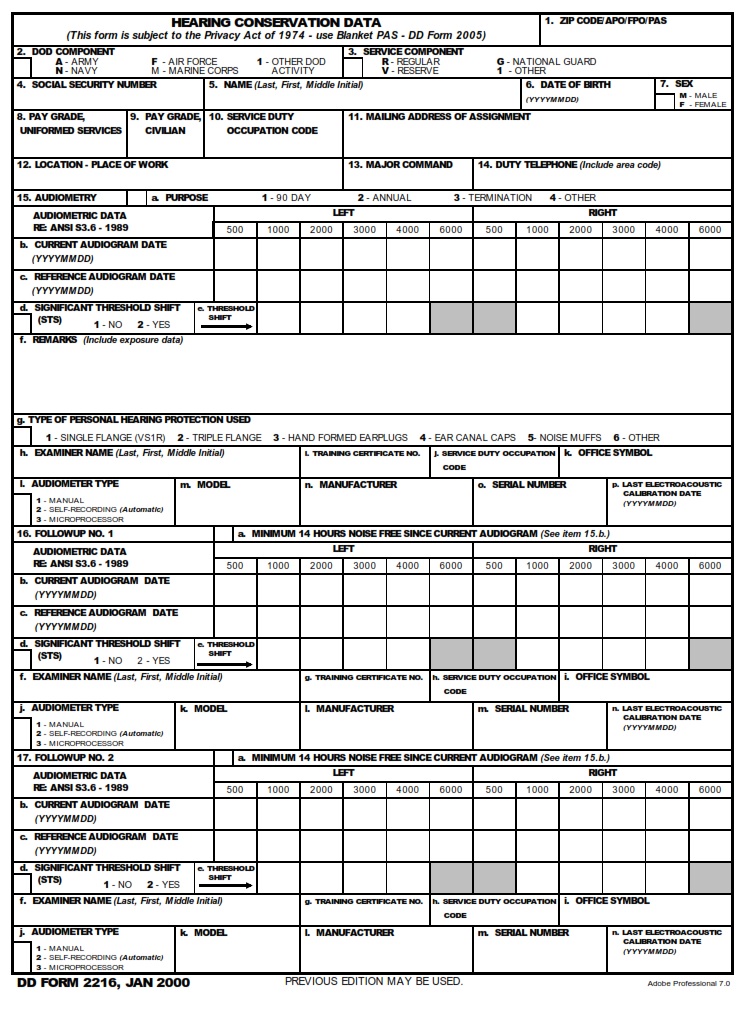DDFORMS.ORG – DD Form 2216 – Hearing Conservation Data – Hearing conservation is an important part of any workplace health and safety program, and a DD Form 2216 (Hearing Conservation Data) can be used to document the effectiveness of a hearing protection program. This form is set out by the U.S. Department of Defense and requires employers to record their workers’ audiological test results, noise measurements, and use of hearing protectors.
Download DD Form 2216 – Hearing Conservation Data
| Form Number | DD Form 2216 |
| Form Title | Hearing Conservation Data |
| Edition Date | 1/1/2000 |
| File Size | 733 KB |
What is a DD Form 2216?
A DD Form 2216 is a Department of Defense (DoD) form used to record hearing conservation data. It documents the results of audiometric testing and other hearing conservation activities, such as noise exposure measurements. This information is collected in accordance with DoD Hearing Conservation Program requirements. The form includes demographic information, medical history, test results, and other pertinent information related to the individual’s hearing health. It also contains instructions for completion by a qualified professional and must be signed off by both the individual undergoing testing and their supervisor or manager. The completed DD Form 2216 should be kept on file for at least five years following its completion date.
The purpose of this form is to document an individual’s baseline audiogram so that any changes may be monitored over time due to occupational noise exposure. Audiometric tests are conducted in a soundproof booth using calibrated equipment to measure frequency-specific hearing thresholds (the lowest level of sound that can be heard). This data is then compared to prior tests or standards established by the DoD Hearing Conservation Program when determining whether any negative changes have occurred in an individual’s auditory system.
Where Can I Find a DD Form 2216?
The DD Form 2216 is available through the Department of Defense (DoD) website. It can be found in a variety of formats, such as PDF and Word doc, depending on which version you need. The form is used to document hearing conservation data for military personnel or DoD contractors who are exposed to hazardous noise levels while working. It includes information regarding the individual’s initial audiometric test results, subsequent audiometric tests, and other pertinent data related to their hearing conservation program. Additionally, it provides instructions on how the form should be completed and signed by an authorized medical professional.
In addition to the DoD website, DD Form 2216 can also be obtained from a healthcare provider or military installation that offers hearing conservation services. If you are unable to find it online or at a service location, you can contact your local base’s occupational health clinic for assistance with obtaining the form. Once completed by an authorized medical professional, it must then be submitted along with an appropriate medical report to ensure proper follow-up care for any identified noise-induced hearing loss or tinnitus conditions.
DD Form 2216 – Hearing Conservation Data
DD Form 2216, also known as the Hearing Conservation Data Form, is a form used by US Department of Defense personnel to track and document an individual’s hearing conservation data. This includes baseline audiometric testing results, annual audiometric testing results, and any additional hearing tests that may be conducted throughout the course of a year. The form can also be used to monitor changes in hearing levels over time. Additionally, it provides guidelines for follow-up action based on test results and other information gathered from the test. It is important for individuals who are exposed to loud noise on a regular basis to have their hearing tested regularly in order to detect any potential changes or damage that may have occurred due to long-term exposure to loud noise. DD Form 2216 helps ensure that person receives the appropriate follow-up care after undergoing a hearing exam or if they experience any dramatic changes in their ability to hear.
